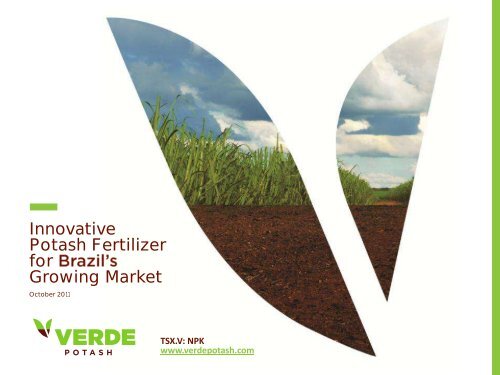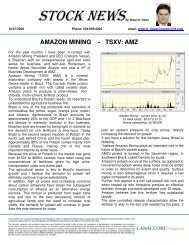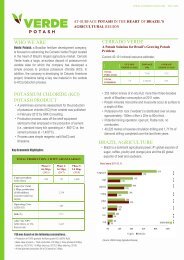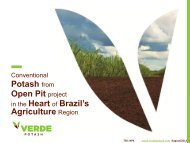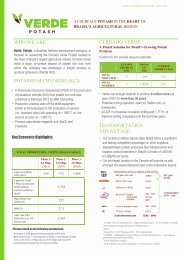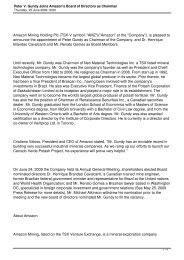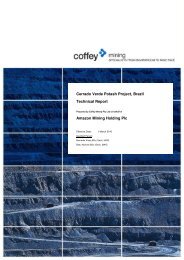Verde fertilizantes - Verde Potash Plc
Verde fertilizantes - Verde Potash Plc
Verde fertilizantes - Verde Potash Plc
Create successful ePaper yourself
Turn your PDF publications into a flip-book with our unique Google optimized e-Paper software.
Innovative<br />
<strong>Potash</strong> Fertilizer<br />
for<br />
Growing Market<br />
October 2011<br />
TSX.V: NPK<br />
www.verdepotash.com
Disclaimer<br />
This presentation contains certain “forward looking statements”, which include but is not limited to, statements with<br />
respect to the future financial or operating performance of <strong>Verde</strong> <strong>Potash</strong> <strong>Plc</strong> (the “Company”), its subsidiaries and<br />
its projects, statements regarding use of proceeds, exploration prospects, identification of mineral reserves, costs<br />
of and capital for exploration projects, exploration expenditures, timing of future exploration and permitting,<br />
requirements for additional capital, government regulations of mining operations, environmental risks, reclamation<br />
expenses, title disputes or claims, and limitations of insurance coverage. Forward looking statements can<br />
generally be identified by the use of words such as “plans”, “expects”, or “does not expect” or “is expected”,<br />
“anticipates” or “does not anticipate”, or “believes”, “intends”, “forecasts”, “budget”, “scheduled”, “estimates” or<br />
variations of such words or phrases or state that certain actions, event, or results “may”, “could”, “would”, “might”,<br />
or “will be taken”, “occur” or “be achieved”. Forward looking statements involve known and unknown risks,<br />
uncertainties and other factors which may cause the actual results, performance or achievements of the Company<br />
to be materially different from any future results, performance or achievements expressed or implied by said<br />
statements. There can be no assurances that forward-looking statements will prove to be accurate, as actual<br />
results and future events could differ materially from those anticipated in said statements. Accordingly, readers<br />
should not place undue reliance on forward-looking statements.<br />
Total resources include all categories unless otherwise stated. All currency are in Canadian $ unless otherwise<br />
stated.<br />
TSXv : NPK<br />
2
<strong>Verde</strong> <strong>Potash</strong><br />
Brazilian fertilizer company<br />
•Founded and led by strong and successful Brazilian team<br />
•Listed on the Toronto Venture Exchange (NPK : TSX-V)<br />
Cerrado <strong>Verde</strong> <strong>Potash</strong> Project<br />
•Phase 1 : 1.1 Mtpy of Thermo<strong>Potash</strong><br />
• Low Capex: US$196.8M<br />
• Strong Economics: NPV : US$445.5M<br />
• Short payback period: 2.38 years<br />
•Phase 2: Conventional <strong>Potash</strong> - KCl<br />
• New technology under development<br />
• University of Cambridge partnership<br />
Investment Highlights<br />
•High grade potash at surface in Minas Gerais State (US$70B<br />
agribusiness GDP)<br />
•60% of Brazil‟s fertilizer consumption takes place in Minas Gerais and<br />
adjacent states<br />
•Government support: tax advantages granted and potential financing<br />
<strong>Potash</strong> rock at surface grading 11% K 2 O<br />
TSXv : NPK<br />
3
Capital Structure & Share Price<br />
Shares Issued 32,374,753<br />
Options 2,946,469<br />
Warrants 72,368<br />
Fully Diluted (Oct 12, 2011) 35,393,590<br />
52 week: Hi/Lo C$10.95/C$2.23<br />
Market Cap (at $6.72)<br />
C$218 million<br />
Average Volume (3 mo.) 46,572<br />
Cash Position (June 30, 2011) ~C$9.2 million<br />
Debt 0<br />
Share Price<br />
$12.00<br />
0.9<br />
$10.00<br />
0.8<br />
0.7<br />
$8.00<br />
0.6<br />
$6.00<br />
0.5<br />
0.4<br />
$4.00<br />
0.3<br />
$2.00<br />
0.2<br />
0.1<br />
$0.00<br />
0<br />
Aug-10 Oct-10 Dec-10 Feb-11 Apr-11 Jun-11<br />
Analyst Coverage<br />
Salman GMP Securities Partners Anoop Prihar<br />
Wellington Mackie Research West Jaret Anderson<br />
Ocean National Equities Bank Robert Winslow<br />
Octagon Ocean Equities Capital Adam Lucas<br />
Kaiser Octagon Bottom Capital Fish (John Max Kaiser) Vichniakov<br />
Salman Partners TBA<br />
TSXv : NPK<br />
4
Management & Directors<br />
Management<br />
Cristiano Veloso Founder, President, CEO<br />
• 12 years experience; Brazilian entrepreneur ex Banco do<br />
Brasil S/A, CEMIG; LL.B, LL.M International Business Law<br />
Maurício Sampaio VP Operations<br />
• 30 years experience; ex President of Brazilian Agribusiness<br />
Association, Operations and Marketing Director for Bunge<br />
Fertilizantes and Operations Director for Fertiza<br />
Pedro Ladeira VP Engineering<br />
• 17 years experience; ex Operations Director at Cementos<br />
Minetti; Process and Production Manager for Holcim Brazil<br />
Jed Richardson VP Corporate Development<br />
• 10 years experience; ex Mining Analyst with Sprott/Cormark<br />
and RBC Capital Markets, Mining engineer with Alcan<br />
Aluminium<br />
Ysao Munemassa Exploration Director<br />
• 41 years experience; ex BP Minerals, VALE, Union Carbide,<br />
INCO, Teck Cominco, Newmont Gold<br />
Derek Fray Metallurgical Consultant<br />
• 45 years experience; University of Cambridge Professor &<br />
Director of Research<br />
Rodolfo Silva Pilot Plant Manager<br />
• 17 years experience; past experience includes work with<br />
Usiminas S/A, Magnesita Refratários S/A, Vilma Alimentos<br />
and AMBEV.<br />
Independent Directors<br />
Peter Gundy Chairman<br />
• Former Chairman of Neo Materials Technologies Inc.; VP of<br />
Brascan Inc; Executive VP, Finance of <strong>Potash</strong> Corporation of<br />
Saskatchewan Limited<br />
Getulio Lamartine de Paula Fonseca<br />
• Former General Director National Department of Power &<br />
Water Supply; Executive-Secretary Industry & Commerce<br />
Ministry<br />
Henrique Brandão Cavalcanti<br />
• Former Brazil‟s Minister of the Environment (1994), Deputy<br />
Minister of Mines Energy (1967-69), Deputy Minister of Interior<br />
(1969-74).<br />
Renato Gomes<br />
• Director of the ABCI Institute (Brazilian International Trade<br />
Scholars) Lawyer and member of Brazilian and Portuguese Bar<br />
Associations<br />
Richard Garnett<br />
• PhD. in Economic Geology (Royal School of Mines, UK), MBA<br />
(Cranfield University, UK); Mining Engineer. Has held senior<br />
positions with Rio Tinto, Anglo American, Hudson Bay Mining<br />
and Diamond Fields Resources<br />
TSXv : NPK<br />
5
Millions of Hectares<br />
Brazil’s Agribusiness: Feeding the World<br />
• Brazil has almost 20% of world‟s<br />
undeveloped potential arable land<br />
600<br />
500<br />
400<br />
300<br />
Undeveloped Potential Arable Land<br />
Available<br />
Planted<br />
• The great agricultural frontier is Brazil‟s<br />
Cerrado, or Savannah away from the<br />
Amazon forest<br />
Amazon<br />
Brazil<br />
Cerrado<br />
200<br />
100<br />
0<br />
Brazil US Russia China India<br />
Source: Food and Agriculture Organization, UN<br />
• Brazil has world‟s largest renewable<br />
fresh water reserve<br />
South<br />
America<br />
• Climate allows for multiple crops during<br />
the year<br />
TSXv : NPK<br />
6
Brazil’s Fertilizer Supply & Consumption<br />
Dependency on Imported <strong>Potash</strong><br />
•<strong>Potash</strong> ranks in the top ten of Brazilian<br />
imports by dollar value (2008 #6, 2009 #10)<br />
•Brazilian government targets 2020 to be<br />
fertilizer-independent<br />
•Brazil is to be ranked #1 globally for<br />
potash imports in 2020 at 7.2 million tonnes<br />
of K 2 O 1<br />
Source: FAO,UN<br />
Note<br />
1<br />
Source: FERTECON report (FERTECON, 2009, /15/)<br />
TSXv : NPK<br />
7
Location, Location, Location<br />
~ 60% of Brazil’s<br />
fertilizer consumption<br />
takes place in Minas<br />
Gerais and adjacent<br />
states<br />
Source: ANDA<br />
TSXv : NPK<br />
8
1.1Bt at 9.46% <strong>Potash</strong> at Surface<br />
Tonnage<br />
(Mt)<br />
Avg Grade<br />
Indicated<br />
(7.5% K 2 O cut off grade)<br />
6 23.25 8.83%<br />
7 50.79 9.39%<br />
Total Indicated 74.04 9.22%<br />
Inferred<br />
(7.5% K 2 O cut off grade)<br />
4 74.43 9.20%<br />
6 47.85 8.84%<br />
7 873.59 9.45%<br />
10 28.50 10.10%<br />
11 46.79 8.27%<br />
Funchal Norte 1 105.11 10.32%<br />
Total Inferred 1,176.27 9.46%<br />
1<br />
Funchal Norte is the initial resource estimate announced<br />
in March 2010<br />
Drill Hole Legend<br />
Funchal Norte<br />
(Inferred Resource<br />
announced in March<br />
2010)<br />
Third Zone<br />
(Results to be released in<br />
Q4/2011)<br />
17,000m drilling program<br />
Zones 4, 6, 7, 10, 11<br />
(Drilled and announced<br />
in Aug 2011)<br />
8,950m drilling, 143<br />
holes<br />
9
Transportation Advantage<br />
From Saskatchewan to Brazil<br />
$43.29 1<br />
$30-35<br />
$80-115<br />
Saskatchewan /tonne Port of Vancouver /tonne Port of Santos /tonne NPK Blenders<br />
Total: $153-193/tonne<br />
1<br />
Government of Canada, Ministry of Transportation<br />
TSXv : NPK<br />
10
Thermo<strong>Potash</strong> Scoping Study<br />
Production Rate<br />
(Brazil market share of <strong>Potash</strong><br />
“K 2 O”)<br />
1.1Mtpy 1<br />
(2%)<br />
2.2Mtpy 1<br />
(4%)<br />
NPV (10%) US$445.5m US$844.1m<br />
NPV (12%) US$331.6m US$642.0m<br />
IRR 32.7% 40.0%<br />
Operational Cost US$41.80/t US$36.36/t<br />
CapEx<br />
Contingency<br />
Pre-construction<br />
Total CapEx<br />
US$155.3m<br />
US$23.3m<br />
US$18.2m<br />
US$196.8m<br />
US$218.4m<br />
US$32.8m<br />
US$18.2m<br />
US$269.4m<br />
Payback 2.38 years 1.87 years<br />
NI 43-101 Preliminary Economic Assessment Completed<br />
•PEA completed by SRK Consulting (U.S.), Inc. studied open pit mining and pyrometallurgy process to create the<br />
Thermo<strong>Potash</strong> fertilizer; KCl reference price used was $515 vs. today‟s KCl price of $654<br />
NOTE<br />
1<br />
These figures can be found on page IV of the Preliminary Economic Assessment available on SEDAR published on December 13, 2010<br />
TSXv : NPK<br />
11
Limestone for Thermo<strong>Potash</strong> Production<br />
Resource<br />
Category<br />
Tonnage<br />
(Mt)<br />
Avg. Grade<br />
(CaO)<br />
Indicated 89 54.71%<br />
Inferred 180 54.65%<br />
TSXv : NPK<br />
12
Thermo<strong>Potash</strong> : Benefits<br />
Benefits to farmers<br />
• Provides potash in a slow release form<br />
• Provides substantial doses of other<br />
macronutrients<br />
• Reduces limestone use for pH correction<br />
• No change to final fertilizer application<br />
quantities or techniques<br />
Benefits to fertilizer blenders<br />
• Overseas imports price is set 2 months<br />
before it arrives at facility, plus possible<br />
port delays<br />
• 60% of fertilizer consumption occurs in 4<br />
month window<br />
• Transport distance creates unusable<br />
powder from granules<br />
• Potential to replace 581,236 tonnes of<br />
imported KCl in the region<br />
Port of Santos<br />
TSXv : NPK<br />
13
Brazilian Government Commitment<br />
Memorandum of Understanding (“MOU”) Signed<br />
with State of Minas Gerais<br />
(see April 7, 2011 release)<br />
•Potential financing for working capital and fixed<br />
investment support; funds administered by the<br />
Development Bank of Minas Gerais (BDMG)<br />
•Secretary of Finance‟s approval of special tax treatment<br />
defined as:<br />
• Suspension of “ICMS” tax payable on:<br />
a) imports of foreign goods;<br />
b) imports of foreign raw materials;<br />
c) purchases of domestic raw materials<br />
• Eeffective tax load of 4% payable on sales of<br />
fertilizer products<br />
Minas Gerais State Governor, Antonio Augusto, and<br />
Cristiano Veloso, <strong>Verde</strong> <strong>Potash</strong>‟s CEO<br />
TSXv : NPK<br />
14
Beyond Thermo<strong>Potash</strong>: Conventional KCl<br />
• Method invented for reacting <strong>Verde</strong>‟s<br />
potassium rich rock with a simple mixture of<br />
salts to form water-soluble potash<br />
• Invented by Dr. Derek Fray, Professor and<br />
Director of Research at the University of<br />
Cambridge, UK, sponsored by <strong>Verde</strong><br />
• Reactions occur at moderate temperatures of<br />
800-1,000°C<br />
• The route allows for the production of SOP<br />
and KCl<br />
• <strong>Verde</strong> has commissioned a leading<br />
commercial lab to scale up the current<br />
processing concept to industrial levels<br />
• If the process proves economic it could<br />
revolutionize the <strong>Potash</strong> market<br />
Potassium rich rock<br />
Dr Derek Fray, University of Cambridge, UK<br />
TSXv : NPK<br />
15
Apatita Phosphate Project<br />
• 30km of mineralized phosphate with<br />
widths between 1km and 5km (see<br />
November 8, 2010 release)<br />
• Average grade of 7.13% P 2 O 5 from 435<br />
surface grab samples<br />
• Initial drilling program provided<br />
encouraging results at two prospect<br />
regions:<br />
• Alto da Serra zone : -18m @ 3.00% P 2 O 5<br />
• Nau de Guerra zones:- 7m @ 3.88% P 2 O 5<br />
- 16m @ 3.00% P 2 O 5<br />
• First concentration test result: 29.8% P 2 O 5<br />
with significant potential for improvement<br />
TSXv : NPK<br />
16
Key Milestones<br />
Cerrado <strong>Verde</strong> <strong>Potash</strong><br />
Milestones<br />
Updated Resource<br />
Calculation<br />
TK Registration<br />
TK Feasibility Study<br />
TK Construction<br />
TK Commissioning<br />
Cambridge Technology<br />
Update<br />
2011 2012 2013 2014<br />
Q4 Q1 Q2 Q3 Q4<br />
Other<br />
Apatita Phosphate Resource<br />
Calculation<br />
TSXv : NPK<br />
17
Appendix<br />
18
<strong>Verde</strong>’s Advantage<br />
<strong>Verde</strong>‟s<br />
K Rock<br />
Carnallite<br />
Sylvinite<br />
Depth<br />
0 m<br />
Open Pit Mining<br />
500 - 1000m<br />
Solution Mining<br />
1000 - 1500m<br />
Conventional Underground<br />
Grade<br />
10-13% K 2 O<br />
10-14% K 2 O<br />
20-25% K 2 O<br />
Time<br />
2 yrs<br />
5-7 years<br />
7-10 years<br />
Cap-Ex<br />
$200 million<br />
$1-2 billion<br />
$2-3 billion<br />
Op Cost<br />
Energy Costs<br />
Low mining costs<br />
Fluid and Boreholes<br />
Solution Separation<br />
Conventional Mining<br />
Flotation Separation<br />
Product<br />
Thermo<strong>Potash</strong><br />
KCl<br />
KCl<br />
TSXv : NPK<br />
19
Process and Operating Costs<br />
Thermo<strong>Potash</strong> Production Process<br />
1. Mining<br />
• Potassium rich rock comes from open pit and<br />
the limestone comes from suppliers in the<br />
surrounding area or <strong>Verde</strong>‟s quarry<br />
2. Grinding<br />
• Potassium rock and limestone are ground by<br />
upright rod mill<br />
3. Mixing<br />
• The ground rock and limestone are mixed<br />
and 4% moisture is added<br />
4. Pelletization and Drying<br />
• Material is rolled into pellets by disc<br />
pelletizers, and dried by exhaust gas from the<br />
rotary kiln<br />
5. Rotary Kiln and Quenching<br />
• After drying, pellets go into the rotary kiln to<br />
be heated to 1250 o C and rapidly cooled<br />
6. Packaging of ready Thermo<strong>Potash</strong> product<br />
$18.45<br />
$2.35<br />
$8.91<br />
$1.80<br />
$5.50<br />
$1.76<br />
$3.04<br />
•Energy<br />
•petroleum coke, electricity<br />
•Raw Materials<br />
•limestone<br />
•Labour<br />
1<br />
These figures can be found on pages 17-15 & 17-16 of the Preliminary Economic Assessment<br />
available on SEDAR published on December 13, 2010<br />
Estimated Operating Cost<br />
(1.1mtpy) 1<br />
•Maintenance<br />
•Equipment Operation<br />
•Marketing<br />
•Non-Operating Expenses<br />
•administration<br />
US$41.80/tonne<br />
TSXv : NPK<br />
20
Marketing Study<br />
Cerrado <strong>Verde</strong><br />
Mato Grosso<br />
do Sul<br />
246,621t/y<br />
$179.47<br />
$122.20<br />
Mato Grosso<br />
895,043t/y<br />
$189.85<br />
$130.13<br />
Parana<br />
778,17t/y<br />
$131.01<br />
$63.68<br />
NOTE<br />
1 Weighted-average of the highlighted market<br />
Goias<br />
495,68t/y<br />
$142.64<br />
$112.98<br />
Minas<br />
Gerais<br />
896,051t/y<br />
$182.31<br />
$160.04<br />
Sao Paulo<br />
722,513t/y<br />
$131.77<br />
$90.92<br />
Bahia<br />
325,18ty<br />
$141.61<br />
$93.98<br />
Highlighted Market<br />
Annual Market Potential:<br />
4,359,267 tonnes<br />
Potential Sale Price:<br />
US$179.47/t 1<br />
Delivery-adjusted Price:<br />
US$122.20/t 1<br />
Marketing Study<br />
• Agroconsult conducted an<br />
independent market study to<br />
understand potential sale price and<br />
market size of Thermo<strong>Potash</strong><br />
• Prices derived exclusively on how<br />
blenders can optimize NPK formulas<br />
using Thermo<strong>Potash</strong> and keep raw<br />
material costs equal<br />
TSXv : NPK<br />
21
Pricing Estimates<br />
Optimized Formulation vs. Standard Formulation in 4-20-20 Fertilizer 1<br />
Am. Sulphate<br />
(US$258.52/t)<br />
Standard - w/o TK<br />
Optimized Formulation - w/ TK<br />
Weight<br />
(kg)<br />
Price<br />
(US$)<br />
N P K Weight<br />
(kg)<br />
Price<br />
(US$)<br />
N P K<br />
74.2 19.18 1.48% 0.00% 0.00% 5.6 1.45 0.11% 0.00% 0.00%<br />
SSP<br />
(US$253.07/t)<br />
MAP<br />
(US$514.06/t)<br />
KCl<br />
(US$515.55/t)<br />
Thermo<strong>Potash</strong><br />
($182.31/t)<br />
352.8 89.28 0.00% 7.06% 0.00% 0 0.00 0.00% 0.00% 0.00%<br />
239.7 123.22 2.52% 12.94% 0.00% 370.4 190.41 3.89% 20.00% 0.00%<br />
333.3 171.83 0.00% 0.00% 20.00% 288.6 148.79 0.00% 0.00% 17.32%<br />
0 0 0.00% 0.00% 0.00% 335.5 61.16 0.00% 0.00% 2.68%<br />
Total Weight 1000 403.53 4.00% 20.00% 20.00% 1000 401.81 4.00% 20.00% 20.00%<br />
NOTE<br />
1 Agroconsult (see press release dated October 26, 2010)<br />
TSXv : NPK<br />
22
Thermo<strong>Potash</strong> Agronomic Results<br />
Nutrient Availability Tests<br />
(See August 11, 2010 release)<br />
• Tests showed that Thermo<strong>Potash</strong><br />
(TK) provided statistically equivalent<br />
nutrients to plants as KCl<br />
Slow and Controlled Release<br />
(See October 15, 2010 release)<br />
• Resin tests confirmed slow<br />
release properties of<br />
Thermo<strong>Potash</strong> (best suited for<br />
Brazilian soils)<br />
Limestone Replacement Tests<br />
(See October 14, 2010 release)<br />
• Every tonne of Thermo<strong>Potash</strong> used<br />
reduces limestone required by 490<br />
kg<br />
Potassium Leaching Tests<br />
(See December 16, 2010 release)<br />
• TK suffers minimal nutrient loss as a<br />
result of leaching, whereas KCl loses<br />
26% under the same conditions<br />
Product Efficacy Tests<br />
(See May 16, 2011 release)<br />
• Tests showed Thermo<strong>Potash</strong><br />
results were 17% better than KCl<br />
TSXv : NPK<br />
23
<strong>Potash</strong> Price ($/t)<br />
<strong>Potash</strong> Shipments (MMt)<br />
Why It Hasn’t Been Done Before?<br />
1200<br />
120<br />
1000<br />
Shipments<br />
Brazil<br />
100<br />
800<br />
China<br />
80<br />
600<br />
400<br />
200<br />
0<br />
. . . . . . . . . . . . . . . . . . . . . . . . . . . . . . . . . . . .<br />
2002 2003 2004 2005 2006 2007 2008 2009 2010E<br />
60<br />
40<br />
20<br />
0<br />
<strong>Potash</strong> price was too low<br />
• When <strong>Verde</strong>te was first tested KCl<br />
was only $70/t<br />
• In 2007 KCl price was still $200/t<br />
reaching $1100/t during 2008<br />
• Now $400/t FOB, $600/t in Brazil<br />
Existing Production Gov’t Built<br />
• Large conventional mines are<br />
privatized government assets<br />
• No new large mines since 1980‟s<br />
• Now it would cost billions with long<br />
lead times to production<br />
TSXv : NPK<br />
24
<strong>Potash</strong> is essential for energy in Brazil<br />
Sugarcane<br />
• Uses 160kg/ha of potash<br />
per year, 55% of total<br />
nutrient required (In<br />
comparison, corn uses<br />
140kg/ha of potash, 31%<br />
of req’d nutrient)<br />
• Sugarcane is grown in<br />
about 8 million hectares of<br />
land, of which 55% of the<br />
harvest is used for ethanol<br />
production<br />
Milling and Refining<br />
• Once harvested, sugarcane<br />
is milled to collect the<br />
juice that contain 10-15%<br />
sucrose<br />
• Juice is filtered and refined<br />
Ethanol Production<br />
• Ethanol is produced by<br />
microbial fermentation of<br />
the sugar<br />
• Water is removed by<br />
distillation and dehydration<br />
Electricity Generation<br />
•Bagasse is burned to generate<br />
electricity for production<br />
plant and grid<br />
Ethanol<br />
replaces about<br />
50% of the fuel<br />
needed to<br />
operate light<br />
vehicles on<br />
gasoline<br />
Bagasse power<br />
generation<br />
represents<br />
4.1% of total<br />
installed<br />
capacity<br />
Ethanol Production Cost<br />
Sugarcane (Brazil): $0.83<br />
Corn (US): $1.14<br />
Ratio energy input to manufacture<br />
to energy output of ethanol<br />
Sugarcane (Brazil): 1:9.3<br />
Corn (US): 1:1.4<br />
TSXv : NPK<br />
25
Thermo<strong>Potash</strong> Partnerships<br />
ArcelorMittal to Fund Agronomic Trials (See Sept. 22, 2009 release)<br />
• Agreement represents a first step in developing corporate demand for Thermo<strong>Potash</strong>. ArcelorMittal<br />
has 170,000ha of cultivated eucalyptus forests for charcoal production.<br />
Agrifirma to Undertake Agronomic Trials (See Nov. 24 & Dec. 9, 2009 release)<br />
• Agreement secures real world field trials of Thermo<strong>Potash</strong> for use in corn and soy plantation, also as<br />
part of process for conversion of Cerrado scrubland for commercial cultivation. Agrifirma is a Jerseybased<br />
land fund with 42,000ha of farmland in Brazil<br />
Sekita to Fund Agronomic Trials (See March 22, 2010 release)<br />
• Agreement establishes a relationship with one of the largest Brazilian vegetable producers.<br />
Thermo<strong>Potash</strong> to be tested in real world conditions for use with various vegetables. Its farms are<br />
located less than 10km from the Cerrado <strong>Verde</strong> Project<br />
Included in Sugarcane Fertilizer Taskforce (See August 4, 2009 release)<br />
• ROCKAPL („Rock‟ Arranjo Produtivo Local) is a collaborative effort between government and private<br />
enterprise focused on developing fertilizer alternatives for sugarcane destined for ethanol production<br />
Universidade Fedederal de Uberlandia<br />
University of Uberlandia Undertakes Agronomic Trials (See December 9, 2009 release)<br />
• Agreement with Dr. Gaspar Korndörfer, Professor of Agriculture at the Universidade Fedederal de<br />
Uberlandia, secures initial agronomic studies used for the planning of Amazon‟s metallurgical test<br />
work and laboratory scale tests on the application of Thermo<strong>Potash</strong><br />
University of Lavras Agreement (See August 31, 2010 release)<br />
• Agreement with the University of Lavras to complete a full slate of tests to register the Thermo<strong>Potash</strong><br />
product as a fertilizer in Brazil<br />
TSXv : NPK<br />
26
<strong>Potash</strong> Rock vs. Oil Sands<br />
Oil Sands<br />
<strong>Potash</strong> Rock<br />
Commodity Crude oil <strong>Potash</strong><br />
Potential Resource 170 billion barrels of oil equivalent 1.1 billion tonnes<br />
Cause for<br />
development<br />
Life Stage<br />
Key Companies<br />
• Dependence on oil imports in the 1970s<br />
• Rising price of oil making the projects<br />
economic<br />
45 companies developing 82 projects;<br />
25 projects in operation<br />
Major International Oil Companies<br />
Suncor, Nexen, Cenovus, Husky<br />
• Dependence on potash imports in<br />
Brazil with growing agriculture<br />
industry<br />
<strong>Verde</strong>: feasibility study in development<br />
<strong>Verde</strong> <strong>Potash</strong><br />
Sector Value C$120 billion C$200 million<br />
Oil sands<br />
• Oil sands now an accepted source of crude oil shows the potential our new source of potash<br />
• Oil sands deposits were developed because of increasing dependence on oil imports; Brazil‟s<br />
dependence on potash imports can be reduced by this development<br />
• In 30 years, oil sands emerged from a niche technology to a mainstream source of oil,<br />
supplying 6.6% of U.S. oil consumption. Our potash rock may follow suit, providing an answer<br />
for growing global potash need in the future<br />
TSXv : NPK<br />
27
Phosphate in Brazil<br />
Company Project Status Type<br />
Resource 1<br />
(Mt)<br />
Reserve 2<br />
(Mt)<br />
Avg<br />
Grade<br />
P 2 O 5 (%)<br />
P 2 O 5<br />
Concentr. 3<br />
Production<br />
Capacity 4<br />
(ktpy)<br />
Fosfertil/Vale Tapira Operating Carbonatite 1,309.2 7.69 35.5 2,030<br />
Copebras/Anglo Ouvidor Operating Carbonatite 256.7 7.63 38.0 1,300<br />
Vale Araxa Operating Carbonatite 88.7 11.12 35/33 910<br />
Fosfertil/Vale Catalao Operating Carbonatite 223.6 8.96 36/34 1,209<br />
Vale Cajati Operating Carbonatite 85.1 5.45 36.0 528<br />
Fosfertil/Vale Patos Operating Metasediments 304.6 12.36 24.0 150<br />
Fosfertil/Vale Salitre Implementati<br />
on<br />
Vale Anitapolis Implementati<br />
on<br />
Carbonatite 852.0 10.74 - 1,600 forecast<br />
Carbonatite 54.0 9.01 - 300 forecast<br />
MBAC 5 Itafos Operating Metasediments 44.0 5.39 28/30 50<br />
Notes<br />
1<br />
Resource and Grades: Salitre-DNPM 1975/Anitapolis:, DOU 1980 (DOU = Official Diary of Brazil)<br />
2<br />
Reserve and Grades: DNPM 2006 Mineral Annuary<br />
3<br />
Concentration/Production: ANDA Annuary 2008<br />
4<br />
Major Phosphate Rock Producer by Bete,Inc. for Cargill Fertilizer, inc 1998. Values updated to 2010 including exchange variation and inflation<br />
5<br />
BMO – MBAC report figures April 2010 and Website info September 2010 TSXv : NPK<br />
28
TSX-V:NPK<br />
www.verdepotash.com


